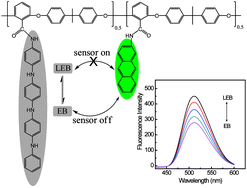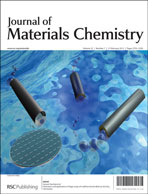We describe the synthesis of a novel poly(aryl ether), containing pendant oligoaniline and anthracene moieties (PAE-p-OA), and both side chains present in equal amounts. Structures were confirmed spectroscopically via nuclear magnetic resonance (NMR), morphological data ascertained viaX-ray diffraction (XRD), and thermal stability probed viathermogravimetric analysis (TGA). Electrochemical and photophysical properties were also investigated using cyclic voltammetry and UV-Vis and fluorescence spectroscopy. This material exhibits an interesting fluorescent response to redox active species. When PAE-p-OA is in the reduced state, oxidative materials interact with the oligoaniline side chains resulting in a progression from leucoemeraldine base (LEB) to the emeraldine base (EB). The resulting change in molecular conformation of the oliganiline unit increases its propensity for interaction with the anthracene side chain (corroborated by molecular modeling), leading to decreased fluorescence via quenching and thus “turn off” fluorescence sensing. When PAE-p-OA is in the oxidized state, reduction of the oligoaniline from the EB to the LEB via interaction with a reductive species delivers “turn on” fluorescence sensing via decreased interaction between the oligoaniline and anthracene side chains, again due to a change in the molecular conformation of oligoaniline.

You have access to this article
 Please wait while we load your content...
Something went wrong. Try again?
Please wait while we load your content...
Something went wrong. Try again?


 Please wait while we load your content...
Please wait while we load your content...